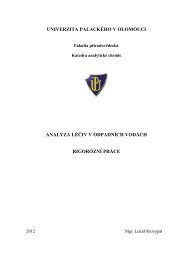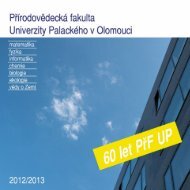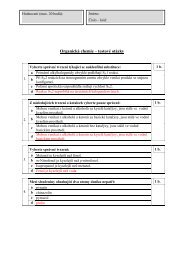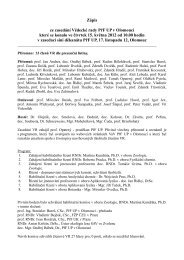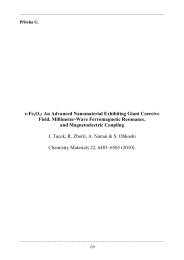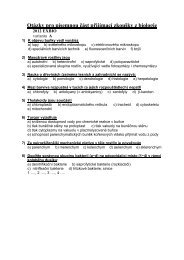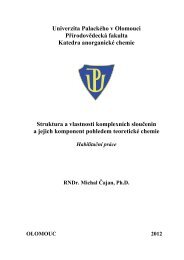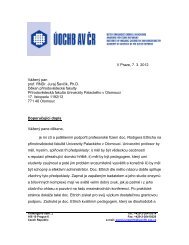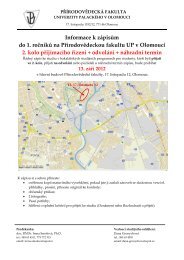A comparative structural analysis of direct and indirect shoot ...
A comparative structural analysis of direct and indirect shoot ...
A comparative structural analysis of direct and indirect shoot ...
You also want an ePaper? Increase the reach of your titles
YUMPU automatically turns print PDFs into web optimized ePapers that Google loves.
58 M. Volgger et al.<br />
Fig. 6 a–h After 24 h <strong>of</strong> incubation: adaptation <strong>of</strong> root hairs to<br />
plasmolytic conditions. The left column shows whole roots <strong>and</strong> root<br />
hairs in increasing concentrations <strong>of</strong> mannitol, dark field mode; the<br />
right column shows single root hairs under these conditions in higher<br />
magnification, bright field mode. Bar left column 30 μm; bar right<br />
column 10 μm<br />
Organisation <strong>of</strong> the cytoplasm <strong>and</strong> deposition<br />
<strong>of</strong> wall material<br />
In root hairs <strong>of</strong> Tradescantia fluminensis, Schröter <strong>and</strong><br />
Sievers (1971) observed differences in cellular organisation<br />
after 3 h in 0.05 molar glucose solutions <strong>and</strong> a cessation <strong>of</strong><br />
growth in existing hairs.<br />
Our results <strong>of</strong> wheat root hairs show that the cytoarchitecture<br />
is not influenced dramatically during osmotic<br />
changes; even in plasmolysed root hairs, the clear zone<br />
<strong>and</strong> polar organisation <strong>of</strong> the cells are maintained for a long<br />
time independent <strong>of</strong> the osmotic value <strong>of</strong> the medium. In<br />
addition, the deposition <strong>of</strong> new cell wall is continuous<br />
during all stages <strong>of</strong> plasmolysis. It is secreted into the<br />
emerging plasmolytic space between the cell wall <strong>and</strong> the<br />
protoplast. Obviously, the tip-focussed gradient <strong>of</strong> exocytotic<br />
vesicles <strong>and</strong> the continuing organelle motility allow<br />
for a constant supply <strong>of</strong> wall components <strong>and</strong> for continued<br />
cell wall synthesis. In plants, disrupted cellulose synthase<br />
may form callose (Brett 2000). Depending <strong>of</strong> the speed <strong>of</strong><br />
plasmolysis, wall depositions appear dispersed or as solid<br />
rings. They remain in place <strong>and</strong> become especially visible<br />
after renewed plasmolysis.<br />
This new cell wall can be observed by aut<strong>of</strong>luorescence<br />
or after callose staining with aniline blue just exterior <strong>of</strong> the<br />
plasma membrane, <strong>and</strong> it appears brighter than within the<br />
plasmolytic space. Electron micrographs <strong>of</strong> cell walls built<br />
under osmotic stress show a rather loose consistency <strong>and</strong><br />
confirm the deposition <strong>of</strong> mainly pectins <strong>and</strong> hemicelluloses<br />
in moss protonemata (Schnepf et al. 1986) <strong>and</strong> in root<br />
hairs <strong>of</strong> T. fluminensis (Schröter <strong>and</strong> Sievers 1971). In root<br />
hairs <strong>of</strong> Zea mays <strong>and</strong> T. aestivum, also callose depositions<br />
have been observed after turgor reduction (Lerch 1960). In<br />
Tradescantia virginiana leaf epidermal cells, we also found<br />
striking callose depositions at the plasmolysed protoplast,<br />
the inner side <strong>of</strong> the cell wall (Lang et al. 2004).<br />
Plasmolysis seems to be a membrane-driven process which<br />
still takes place after disruption <strong>of</strong> actin micr<strong>of</strong>ilaments with<br />
cytochalasin B (M Volgger, data not shown) <strong>and</strong>, in onion<br />
epidermis cells, plasmolysis <strong>and</strong> Hechtian str<strong>and</strong> formation was<br />
still observed after cytoskeleton elements had been depolymerized<br />
(Lang-Pauluzzi <strong>and</strong> Gunning 2000). In osmotically<br />
stressed cells, additional osmocytotic vesicles are formed to<br />
reduce membrane surface area <strong>of</strong> shrinking protoplasts<br />
(Oparka et al. 1990; Oparkaetal.1996). Interestingly, these<br />
authors demonstrated that osmocytotic vesicles were not<br />
reused in deplasmolysis <strong>of</strong> onion epidermal cells.<br />
Formation <strong>and</strong> attachment <strong>of</strong> Hechtian str<strong>and</strong>s<br />
In strong plasmolysis, Hechtian str<strong>and</strong>s form between the<br />
plasma membrane <strong>and</strong> the cell wall <strong>of</strong> plant tissue (Hecht 1912;<br />
Attree <strong>and</strong> Sheffield 1985;Oparka1994; Lang-Pauluzzi 2000;<br />
Lang et al. 2004), <strong>and</strong> we show the str<strong>and</strong>s here after FM1-34<br />
<strong>and</strong> DiOC 6 (3) staining in a tip growing system, i.e. root hairs.<br />
Hechtian str<strong>and</strong>s reached right towards the newly built wall at<br />
the clear zone, suggesting that the anchoring sites are readily<br />
incorporated at the very tip. The str<strong>and</strong>s clearly form without<br />
plasmodesmata (Pont-Lezica et al. 1993) <strong>and</strong> thus, the<br />
initiation sites <strong>of</strong> Hechtian str<strong>and</strong>s within the cell wall have




